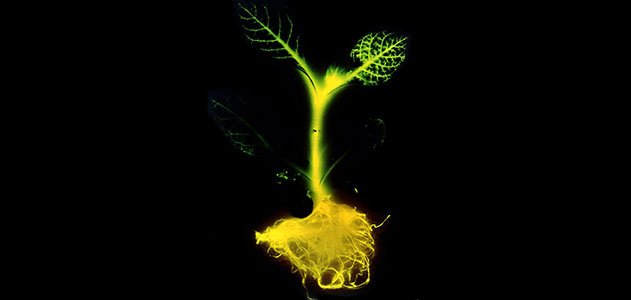
What if we use trees to light our streets instead of electric street lamps? This is the burning question that Antony Evans, project manager of the incredibly successful Glowing Plant Kickstarter campaign, asked potential backers at the crowdfunding site. By using synthetic biology and transgenic technology, Evans and his team has created the world’s first naturally glowing plant available to public.
In an interview with Smithsonian.com, Antony Evans discusses the details of the Glowing Plant project as well as its resounding Kickstarter success. “We knew we had something interesting, because everyone wanted to talk about it. But, we didn’t know it would get this big,” he says. Just how big their Glowing Plant project would get came as a surprise to the team. The campaign initially asked for $65,000 in funding. In 44 days, 8,433 backers responded by pledging $484,013 to the Glowing Plant project.
Part of the reason why the Glowing Plant project caused such an overwhelming response is that Evans and his team was very transparent with their technology. The team gave a clear outline of the entire process from beginning to end, taking their audience through every step that transforms an ordinary plant into a luminous offspring of synthetic biology. The project site also offers a complete maker kit containing full instructions and a vial of Glowing Plant DNA among other materials.
The team used a flowering species named Arabidopsis thaliana for the project, due to its possession of the shortest genome of any flowering plant. Then they used the genes from the marine bacteria Vibrio fischeri to make the plant glow. Evans outlines the entire process of how to make a glowing plant:
“We start with software called Genome Compiler. Genome Compiler allows us to search for gene sequences and then modify those gene sequences in a nice graphical user interface. We use that software to look up the Vibrio fischeri genes, and then we do something called code and optimization, which basically adjusts the sequences so that they [work] in plants instead of in bacteria. We then synthesize the DNA. There is a ‘print’ button, and we ‘print’ that DNA. That emails the file to a company, who makes the DNA for us. They FedEx that back to us, and then we do two things.”
“First, we insert the DNA into some bacteria called agrobacterium. That bacterium is very clever, it has figured out how to do genetic engineering on its own. [The bacterium] inserts the DNA into the female gametes of the plant. We can grow the seeds that come from those flowers, and we’ll have the DNA that we designed on the computer in the plant. The second thing we are doing is using a gene gun, which is a piece of equipment that fires the DNA at high velocity into the cells of the plant. Some of those cells will absorb the DNA and start to express it.”
The glowing plant will give off light as long as it’s alive.
Transgenesis, the process of introducing a foreign gene into a living organism so it will exhibit a new attribute, has been around for some time. From using bacteria genes to make crops insect-resistant to inserting human genes in plants to produce proteins for pharmaceuticals, scientists have tinkered with transgenic organisms to meet modern civilization’s needs. However, there are risks not only in making transgenic organisms but also in releasing them in the environment. Sci-fi and pop culture has thrived on the idea for decades. (Spiderman fanatics note: Andrew Garfield gives a notable geeky but cute Scifi version crash course.) In answer to those who may express concern over distributing synthetic plants to the public, Evans says
“People have been genetically engineering plants for many decades now. We are just following in the footsteps of all of the other plants that have already been released in the last 20 years. We don’t think we are doing anything radically different.”
Following Glowing Plant’s success, Kickstarter recently imposed a ban on distributing GMOs as rewards for backers. While Kickstarter’s representatives did not specify the Glowing Plant as the reason for the restriction, many think otherwise. Read The Verge’s interview with Kickstarter co-founder Yancey Strickler on the subject here.
As of present, the team is working on delivering promised products to their backers. The recent Kickstarter ban became effective last July 31 and did not affect the already completed Glowing Plant campaign.
Yet transgenics and synthetic biology hold great potential for significant scientific advances in the future. Evans himself sees his Glowing Plant project not as a successful lab experiment or a commercial object, but as “a symbol of the future.”
Another important reason for the Glowing Plant’s success is its potential for sustainability. Asked whether he thinks the idea of glow-in-the-dark trees replacing streetlights will someday become a reality, Evans replies: “We do think it should be viable, but it is definitely a long-term goal. The big challenge with the trees is that trees take a long time to grow. Doing experiments on trees and testing different promoters will take a long time. We really need one of a few different technologies to come out.
“One would be a better simulation technology, so that we could simulate the gene sequences on a computer. Two would be a bio printer or something similar, so that we could print a leaf and test realistically the sequences on the leaf. Or, third would be some way of doing gene therapy on trees and adjusting them in situ and using that to change their DNA.
“We do need some developments in one of those before we will be able to really take on big trees.” According to the team’s initial calculations, each glowing tree can illuminate about 1,000 square feet. Evans expects the lighting from a glowing tree to be comparably more diffused compared to a streetlight’s bulb, and much more beautiful.
The project’s focus remains centered on sustainability. Tech Crunch encapsulates Glowing Plant’s long term idea as that of replacing electric or gas-powered lighting with natural lighting from plants.
What do you think of using glowing trees to light streets? Share your thoughts in the comments below.





Leave a Comment